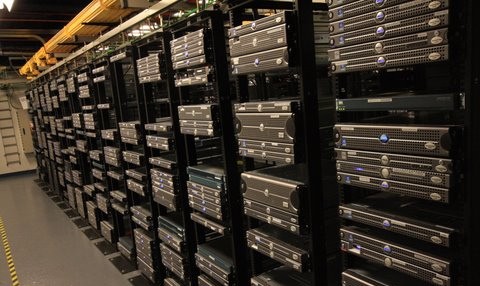Blog posts tagged hosted services
Cloud computing: there's nothing new under the sun
 There’s nothing much new about cloud computing. In fact, it’s basically old-fashioned technology that’s over 25 years old. It’s been rebranded and respun and now gets pumped out in various different guises.
There’s nothing much new about cloud computing. In fact, it’s basically old-fashioned technology that’s over 25 years old. It’s been rebranded and respun and now gets pumped out in various different guises.
When you look at larger companies – like banks and other financial institutions – you can see they’ve been using server-based computing (which is essentially the same thing as cloud computing) for decades. For instance, for years now banks have given their users dumb terminals – little more than a screen, keyboard and mouse – which connect to a central server where all the actual data processing is done.
Big business has used the cloud for years
This server-based computing comes into its own when security, disaster recovery and business continuity are paramount.
In this kind of big-company IT setup, you’ll find computers heavily locked down. Users can’t install their own software. They get access to basic email, which is usually just about sufficient for their needs. Systems are designed and support is provided by the IT team within the company.
This approach leads to a stable, secure and hassle-free IT solution. The phone in the IT support department hardly rings, because there’s not a lot that can go wrong. (Actually, big businesses generally favour ultimate reliability over offering more flexibility to users, because too many support calls are likely to means questions are asked of the IT team.)
The cloud, act two
So, roll on round to around 2006, when a few young, wise IT experts left big businesses. They’d rolled out systems for banks or insurance companies and they saw an opportunity doing the same thing for smaller companies.
Thus was born the early stages of what we now call cloud computing.
Today, the best cloud services are underpinned by the same principles that created those big company IT systems. They generate hardly any IT support calls, because they generate hardly any problems.
The only real difference is that the server hardware is owned by a trusted cloud computing company. They’re the experts who take care of backing everything up to a separate location and monitoring things to make sure users get the best experience in terms of features and functionality.
Users of the service can log in to use software and access their data and applications from anywhere, at any time. Cloud computing: it’s nothing new, but it is very powerful.
- Beginner’s guide to the cloud
- Cloud computing services to get you started
- Can the cloud make you more efficient?
Terry Shepherd is a cloud consultant at Cirrus Stratus.
Cloud computing legal dos and don'ts

Justice in the clouds? (Image: Ariaski on Flickr.)
When businesses use cloud computing, it often means they don't need to buy or install software, or run their own servers. The benefits can be compelling, but cloud computing also presents some interesting legal issues.
Contracts, data protection and copyright
Because cloud computing services involve storing data outside your business, usually on servers operated by another company, there are some contractual, data protection and copyright issues to be aware of:
- The risk of concluding contracts inadvertently. For example, if one of your employees signs up to a cloud-computing service using a computer at work for a purpose related to their employment, then your company could be bound by the terms of that cloud computing service - even if the employee acted without consulting anyone.
- The risk of data protection compliance. If your employees input personal data held by your business into the cloud, your company must comply with its data protection obligations - including those relating to the transfer of data.
- The risk of intellectual property infringement. Your business could be liable if staff post defamatory or copyright-infringing content into the public areas of cloud-computing services. Appropriate policies, procedures and training must be given to employees.
Licensing and software use
A software licence is the set of terms and conditions you agree to before you start using a piece of software or a cloud computing service. Software licensing can be confusing at the best of times, and there are some specific things to remember when you're choosing and using cloud computing services:
- You must have appropriate licences. Some cloud computing services are only licensed to be used at certain computers. So if any of your staff use them at computers without a licence, they commit copyright infringement.
Also, licence terms can be narrow and may limit you to using the service only for your company's own purposes - so check your sub-contractors and business partners can use it too, if they need to. - Using open source software. Many cloud computing services are built on open source software. However, some open source software requires software based upon it to be distributed under the same terms - i.e. made freely available. This could have consequences for your business, if you want to retain the software just for your use.
- Intellectual property indemnity. A cloud computing operator may not always own the intellectual property rights in the software used by their service. If that's the case, that operator has to sub-licence the software to its customers, or arrange a direct licence between its customers and the relevant software company. Check this has been taken care of, or your business could be liable for using unlicensed software.
International implications
It can be hard to tell where cloud computing services actually operate from. Even those that price their services in pounds may be based outside the UK. And if you are dealing with a UK company, they may still store your data on servers in other countries.
In most cases this isn't a problem, but it's wise to aware of the issues that can arise:
- Unexpected obligations. You need to make sure that foreign law does not result in unexpected and binding non-contractual obligations for your business. For example, in some countries you may have duties of good faith in negotiations which do not exist under English law.
- What happens if things go wrong? A cloud computing provider based in the EU can be sued in all the jurisdictions in which it provides services to its customers.
But when a cloud computing provider is based outside the EU, it can be harder to enforce court orders against the company. It's usually best if the governing law of the contract is the local law of the cloud computing provider.
This article is for general purposes and guidance only and does not constitute legal or professional advice.
If Amazon can't make the cloud work, can anyone?

Inside a data centre. Photo from Neospire on Flickr under Creative Commons.
You might have read about problems last month with Amazon’s web hosting service. These affected many well-known websites, including Q&A social network Quora, Foursquare and Reddit.
The outage sparked some debate about how far businesses can rely on cloud services, especially if they’re unable or unwilling to commit to services offering a high level of security and backup.
Don’t let Amazon cloud your decisions
’The cloud’ has been billed as the be all and end all, but like any other business-critical service, you can only count on it if it’s backed up by solid business continuity planning.
Reading between the lines, the Amazon customers least affected by the outage were those with budgets big enough to afford the company’s premium service. They get the peace of mind of knowing that their data’s stored in more than one location.
However, many start-ups and small businesses use cloud services in order to benefit from low up-front costs and manageable ‘pay as you go’ charging. For some, this means they invest in a bottom dollar package from a mass market provider.
But if you don’t choose wisely, taking this route can end up compromising business continuity. What’s more, you may eliminate one of the main reasons for taking the cloud computing route in the first place: complete assurance that your data and systems are protected in every eventuality.
Multiple locations matter
If your chosen cloud computing supplier can only offer hosting from a single location – also called a ‘data centre’ - within your budget allowance, it’s usually worth shopping around. A niche provider that caters specifically for smaller businesses like yours may understand and meet your requirements more effectively.
The key thing is the number of places where your data is stored. Without at least two data centres, you leave yourself at higher risk of service interruptions and failures. Having all your applications and data stored at one site may be no safer than sticking your server in the corner of the office.
True, cloud services have expert engineers available to fix problems quickly, but if your data’s hosted in at least two separate locations it is highly unlikely that both environments will be affected at the same time. So if there’s a problem, you can keep working as normal.
Do remote networks right
My message to companies out there that are questioning cloud technologies after the Amazon outage is to take heed: remote networks are more secure than many traditional systems and, moreover, easier to reinstall should onsite disaster strike.
However, this only applies if you’ve got the right provisions in place. Make sure your cloud provider has more than one data centre, and examine their business continuity plans in detail.
Adrian Smith is MD of Heywood-based IT services provider Flexsys.



